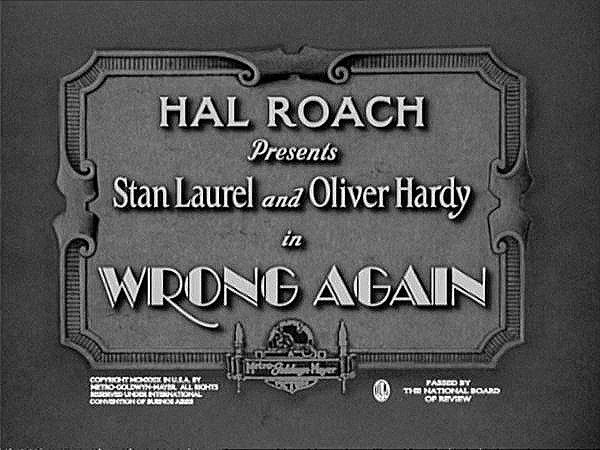
Wrong Again
 |
Available on DVD:![The Lost Films Of Laurfel & Hardy Vol. 4 (Image Entertainment, 2007) [USA]](web_images/dvd-the_lost_films_of_lh_4.jpg)
![The Lost Films Of Laurfel & Hardy Vol. 5 (Image Entertainment, 2000) [USA]](web_images/dvd-lost_films_of_l_h_vol_5.jpg)
![Laurel & Hardy: More Bushes With The Law Classic Shorts (Universal, 2004) [UK]](web_images/dvd-l_h20.jpg)
![Laurel & Hardy: La Collection En DVD Vol. 36 (GE Fabbri) [FRANCE]](web_images/dvd-french36.jpg)
|
|
The owner of a horse (WILLIAM GILLESPIE) tells a stablehand that he is going to give his daughter Blue Boy (the horse) for her birthday present. In mid-conversation a bail of straw and hay is slung over their heads from off-camera. The camera reveals Ollie who emerges from the stable doorway meekly holding a pitchfork and trying to hide his embarrassment. Ollie then tries to squeeze the horse back into the stables via the open doorway at the exact moment Stan tries to come through it, holding a bucket. Stan walks over to turn the hose on in order to fill up the bucket, which has no bottom in it but instead ends up getting himself drenched. Ollie thinks he can do better and takes over; same result. Angrily, he launches the bucket and it hits a guy in a horse and cart. As the boys hide in the stable they overhear two men talking about how Blue Boy has been stolen and the $5000 reward that is being offered for its return. Stan and Ollie remember the horse they were attending to and conjure up a plan to claim the reward for themselves. Elsewhere, two men are seen smuggling the painting 'Blue Boy' into a bedroom but are quickly apprehended by the cops, who then telephone the delighted owner (DELL HENDERSON) to notify him of the good news. The owner instructs the cops to bring over the painting to his house. Soon after Stan and Ollie arrive, with the horse. |
|
The owner throws down the key and tells them to bring Blue Boy into the house. For a moment Ollie is surprised at the request, and tells Stan, who laughs off the idea until Ollie shows him the key. They reluctantly take the horse into the house. Stan leads the horse around the hallway and adjoining rooms as Ollie follows. Ollie then knocks into a life-sized porcalein statue, breaking it into three pieces. When he realises his faux-pas he quickly tries to reassemble it but then is overcome with shyness when handling the 'bottom' part of the figure and so covers it with his jacket. Of course, the inevitable happens and the statue is back-to-front. In the next room Stan is looking for an appropriate place to tie the horse up. He lifts the lid off a huge pot and uses it as a weight to hold the animal to the floor. Ollie removes his jacket from the statue without looking at its newly deformed figure before joining Stan in the sitting room. Ollie explains to Stan that these millionaire-type people are not quite the same as regular people and do everything slightly backwards. They sit together making gestures with their hands to amplify their opinions when the owner of the house calls down to them to put Blue Boy on top of the piano. Stan answers the request as he stands beside the statue in the hallway which is now back-to-front. Remembering what Ollie has just told him about the eccentric behaviour of wealthy people, he gets the joke after some time spent staring at it. Stan returns to the sitting room and leads the horse over to the piano, whilst a bemused Ollie sits and watches with curiosity. Stan tells him of the owner's request to have Blue Boy put on top of the piano and so they begin their arduous attempt to do just that, though Ollie continues to look perplexed. Stan, thinking this is all part of the procedure, imitates Ollie's body language whilst the horse tucks into a plant pot which has been placed on the floor. Stan takes away the plant and steps up onto the piano, hoping the horse will follow him. The horse jumps up as well. Mission accomplished. As Stan shows Ollie how simple it was, the horse jumps back down and begins to gallop around the house chasing Stan who still has the plant pot in his hands. Meanwhile upstairs the owner can hear the commotion going on as he continues to get dressed. Stan passes the pot to Ollie and begins a relay, as the horse now starts to chase him instead. When the horse seemingly doesn't want to do as its told, Stan calls up to the owner and asks if 'he' has ever been on the piano before? The owner confirms that he always keeps him there. Stan does his twisted-hand gesture to imply that he understands the owner is 'backwards' and although the owner immitates him, he doesn't understand what Stan is referring to. |
|
Stan goes back to find the horse drinking out of a small fish tank which is in the hallway. He chases the horse behind a large curtain whilst hanging onto its tail (he was lucky not to get kicked in the face trying that stunt!) When the horse disappears, Stan grabs what he believes to be its tail and starts yanking it out. Of course, we get the gag long before it is revealed Stan is holding onto the curtain rope as Ollie cooly walks past with the horse in the background and gets him up onto the piano. Together Stan and Ollie sit and think about what needs to be done as the horse nudges Stan's hat off. Stan, thinking it was Ollie, laughs and then nudges Ollie's hat off. Ollie doesn't see the funny side of this and responds. Both hats are on the floor when Ollie picks them up before placing each other's on their own heads by mistake. Ollie invites Stan to hop up onto the piano with him and the horse but as he jumps up the weight is too much and the piano leg collapses, spilling the two men onto the floor. The owner hears the crash from upstairs as the boys struggle to lift the piano back up (with the horse still on top) with the broken leg. Ollie crawls underneath the piano to prop it up but gets no help from Stan, who not only steps up onto Ollie's back but also puts his shoe in his face as well. To makes matters worse, the horse then continues to knock Stan's hat off as he tries to assist Ollie. The gag gets worn out by the time Stan manages to prize the leg back under the piano to support the weight of the horse. When the camera pulls back though we see that Stan has in fact propped up Ollie, who is using his weight to hold the whole structure upright. It's an excruciatingly long scene which quickly becomes boring. The boys do finally get Ollie out from under the piano leg and put the proper leg in place just as a car pulls into the driveway. The owner comes to the stairs and tells the boys to pull the curtains because he wants to surprise his mother. He opens the door and in walks his elderly mother with her own surprise - the painting of Blue Boy. The owner points this detail out to the boys, who look sheepish when they reveal their Blue Boy. Ollie leads the horse out of the house as the owner gives chase, pushing the cop into the painting as he barges past him with a shotgun. Moments later the owner is escorted back to the house by a cop who claims his brains were almost shot out. He turns around to reveal his pants smoking from the shotgun blast. A group of people (including CHARLIE HALL) who have turned up to be nosey, are all asked to leave. |
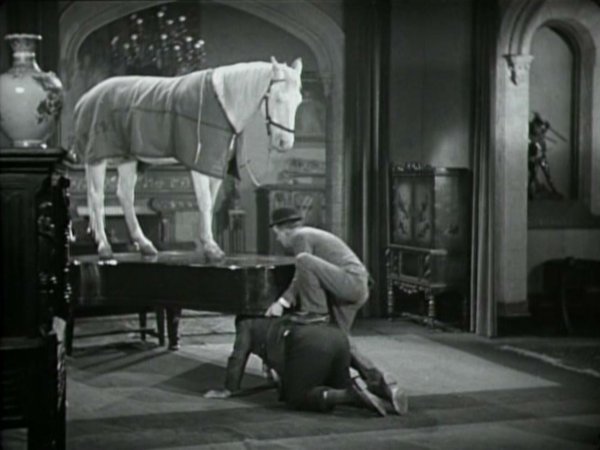 |
Favourite bit The boys are trying to get the horse, Blue Boy, to stand on the piano as instructed by its owner (who believes 'Blue Boy' to be a painting.) When the weight of the horse and the two men causes the leg on the piano to give way they attempt to prop it back up but in doing so end up using Ollie's back - and then his head to keep the piano in its upright position. The scene is overlong and predictable and quickly gets exhausting to watch but it's the best of a mediocre set of otherwise dull comedy routines in the film. |
| Trivia • Copyrighted March 5, 1929. • Released with a synchronized soundtrack. • Director Leo McCarey got the inspiration for the movie's plot while sitting in his dentist's chair and seeing a copy of the famous "Blue Boy" painting on the dentist's wall. • The available print has been composed from material lifted from different sources. The opening MGM credits are not the originals but a recreation using the ones from "Big Business" changing the title and certain names. Most of the film itself was lifted from elements used in the Robert Youngson compilation "Laurel & Hardy's Laughing Twenties" and for this reason the quality of the images constantly switches from excellent to mediocre, since the rest of the film was probably lifted from worn 16mm prints. • Filmed at Milbank & McFie House, 3340 Country Club Drive, Los Angeles, California, USA. • The painting 'Blue Boy' in the film is a real painting by Thomas Gainsborough in circa 1770. • The address of the painting's owner is 46 Collingwood Place. • The statue figure that Ollie breaks is female. • The long scene with Stan standing next to the statue lasts exactly 61 seconds with one cutaway to Dell Henderson the only break. • When the horse first gets up onto the piano you can see the hoove marks already on top before it gets there, indicating a previous rehearsal/take. • The horse knocks Stan's hat off a total of fifteen times. • Are we seriously to believe that Stan Laurel could physically lift not only a piano but one with a horse standing on top of it and hold it at a ninety-degree angle with his own strength without any assistance? At one point he even does it one-handed! My opinion • One of my least favourite Laurel & Hardy silent films. Utterly boring. |
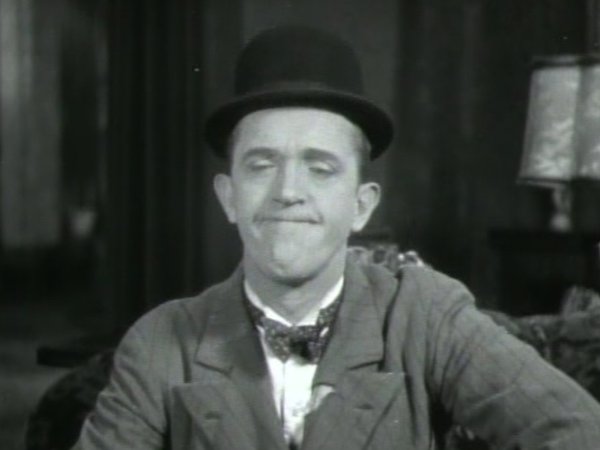 |
Stan Laurel Stan |
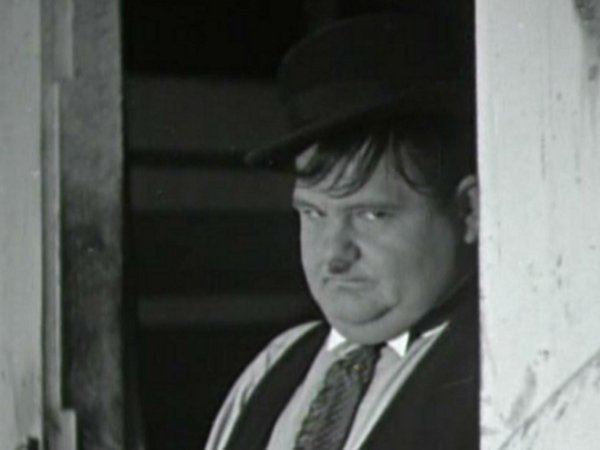 |
Oliver Hardy Ollie |
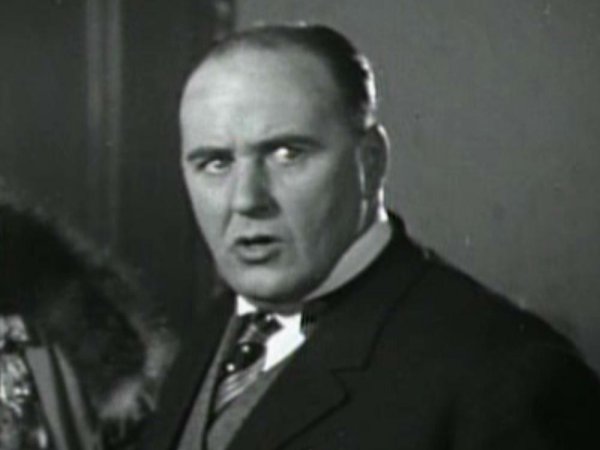 |
Dell Henderson Painting owner |
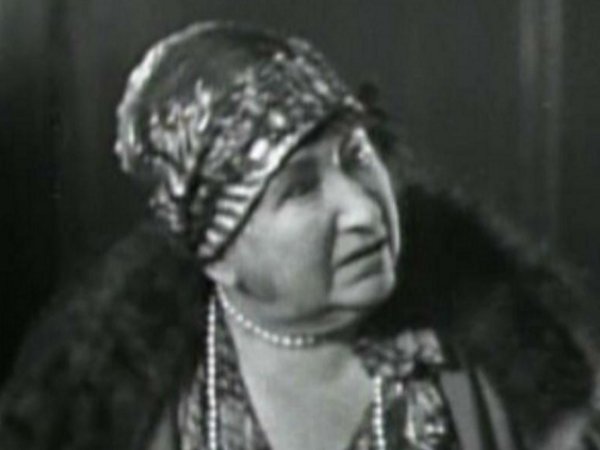 |
Josephine Crowell Painting owner's mother |
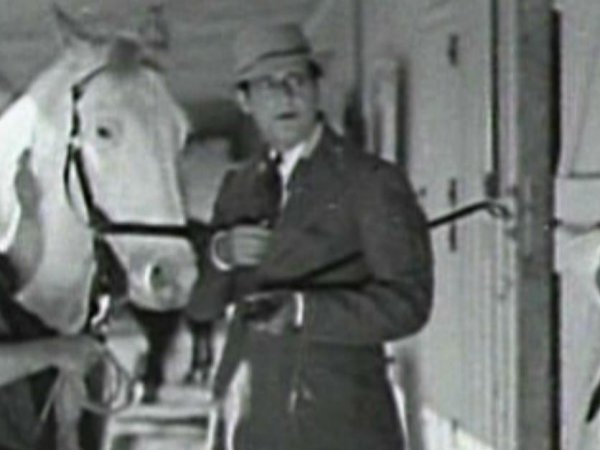 |
William Gillespie Horse owner |
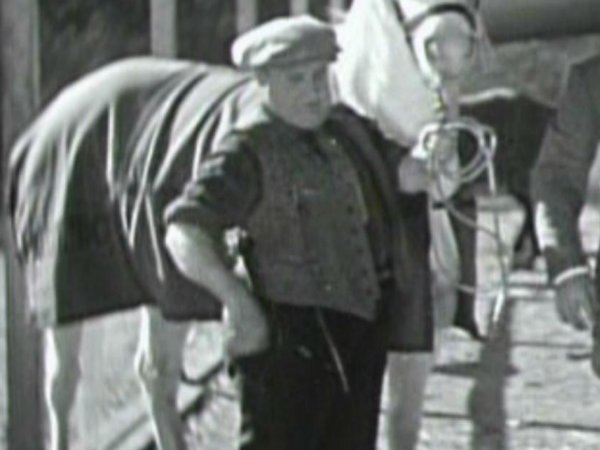 |
Fred Holmes Stableboy |
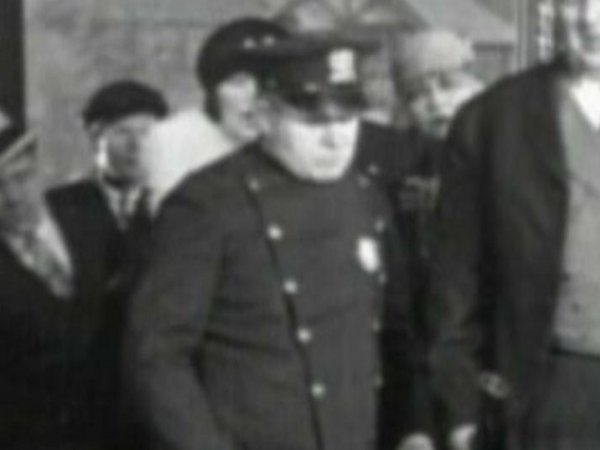 |
Harry Bernard Policeman |
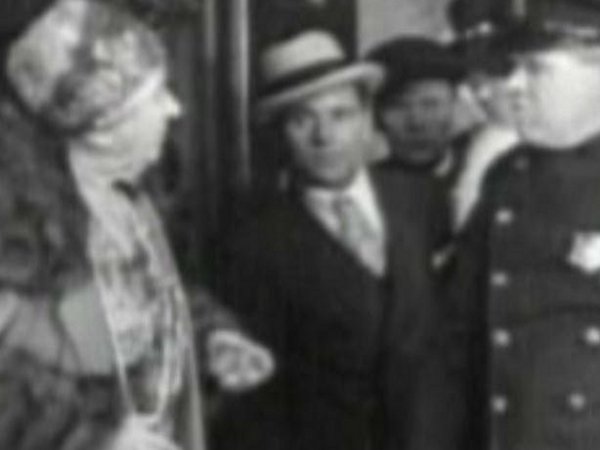 |
Charlie Hall Neighbor |
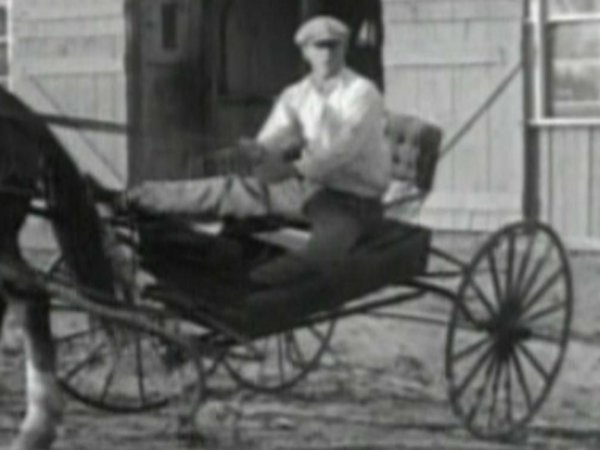 |
Jack Roach Man on buckboard |
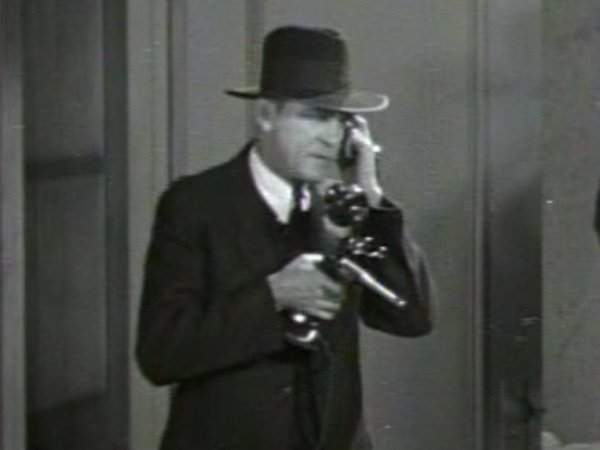 |
Sam Lufkin Sullivan |
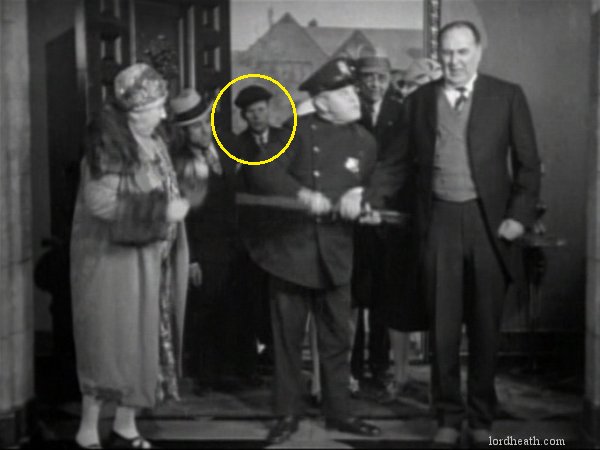 |
Ed Brandenburg Chauffeur |
Fred Kelsey [?] |
Anders Randolf [?] |
![[Unidentified] in Wrong Again (1929)](web_images/unknown_2___wrong_again.jpg) |
UNIDENTIFIED Gentleman with newspaper at stables |
![[Unidentified] in Wrong Again (1929)](web_images/unknown_3___wrong_again.jpg) |
UNIDENTIFIED Gentleman #2 at stables |
![[Unidentified] in Wrong Again (1929)](web_images/unknown_4___wrong_again.jpg) |
UNIDENTIFIED Painting thieves |
![[Unidentified] in Wrong Again (1929)](web_images/unknown_1___wrong_again.jpg) |
UNIDENTIFIED Second cop |
| CREDITS (click image to enlarge) | INTERTITLES (click image to enlarge) |
 |
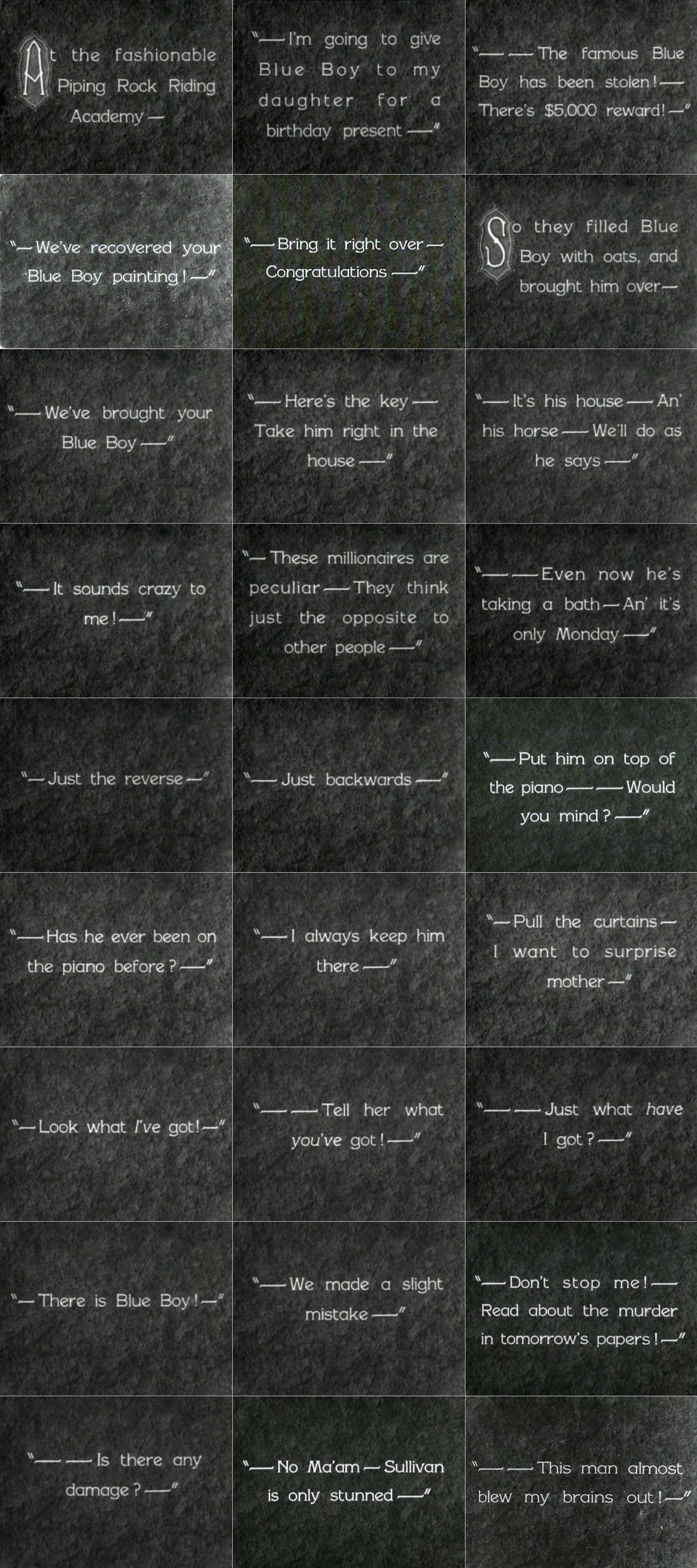 |
| POSTER (click any image to enlarge) 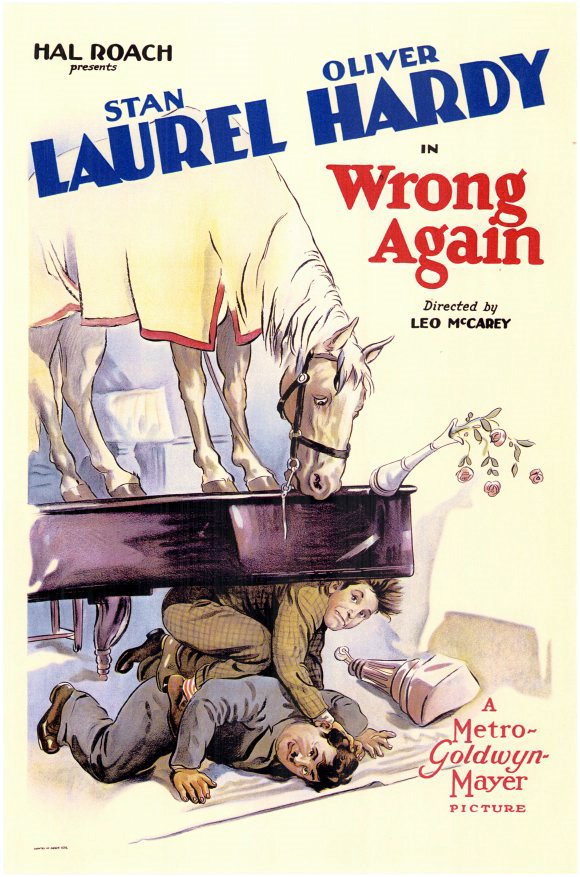
|
| LOBBY CARDS (click any image to enlarge) 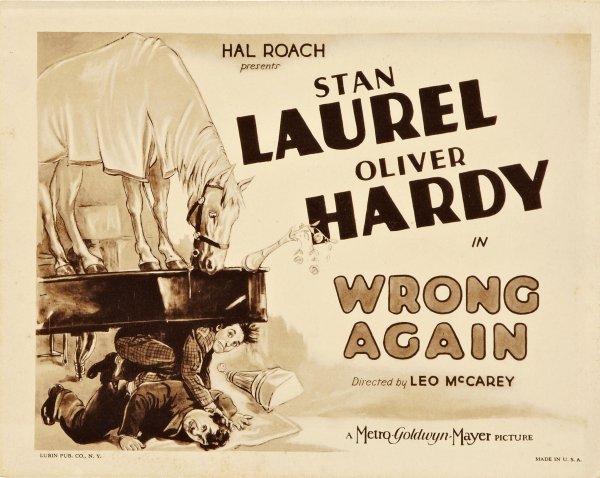
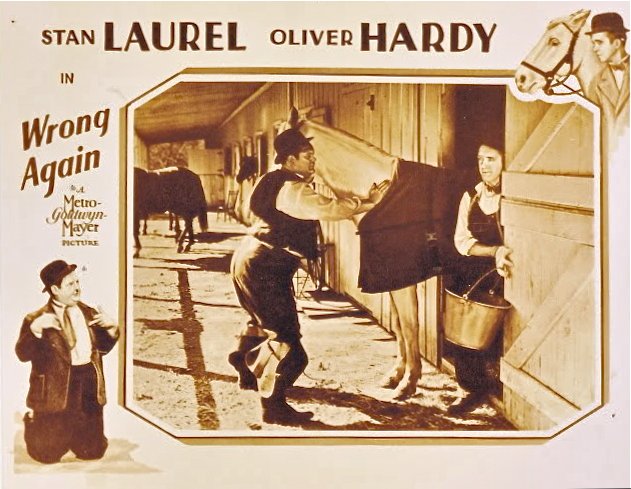
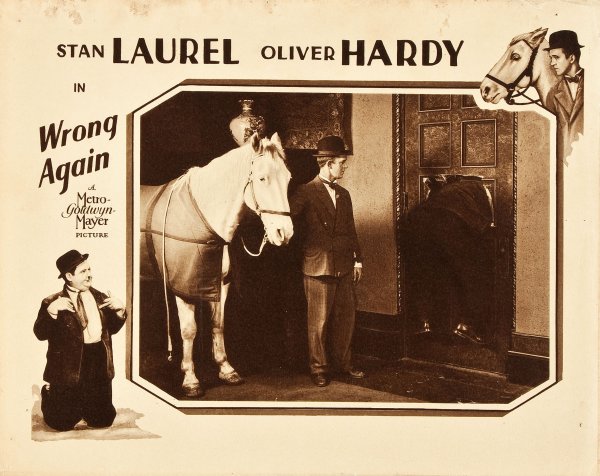
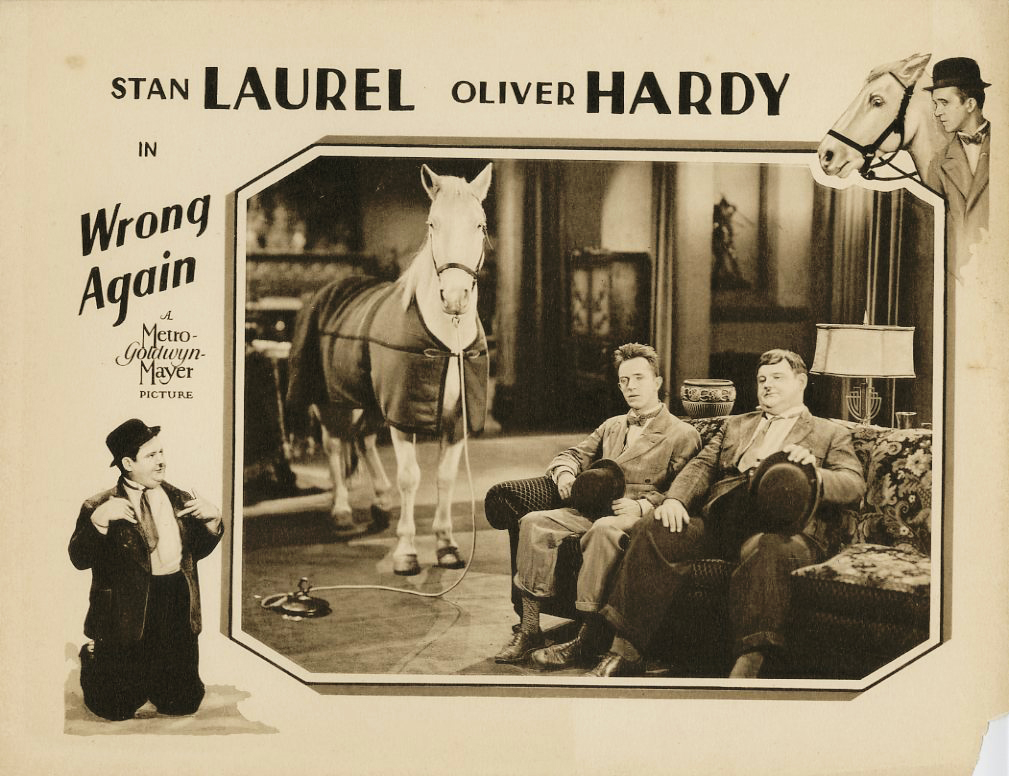
|
| STILLS (click any image to enlarge) 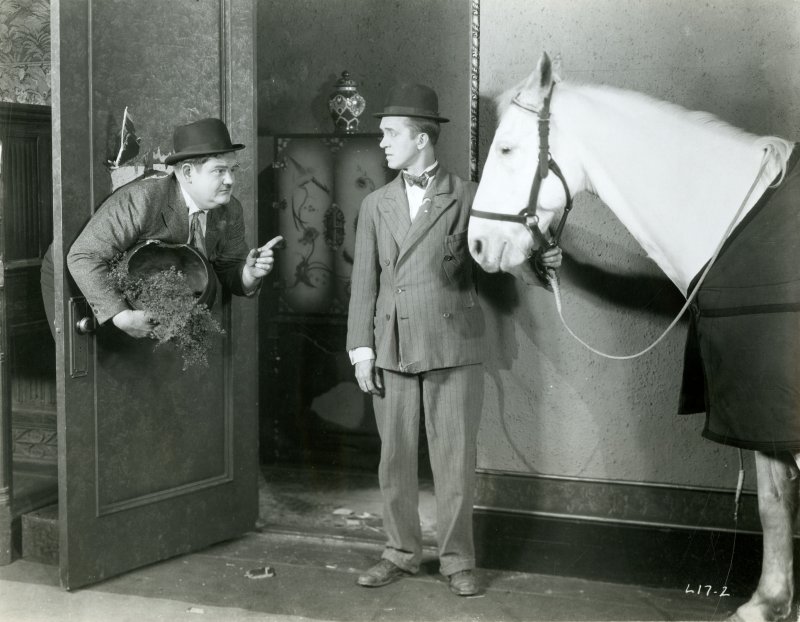
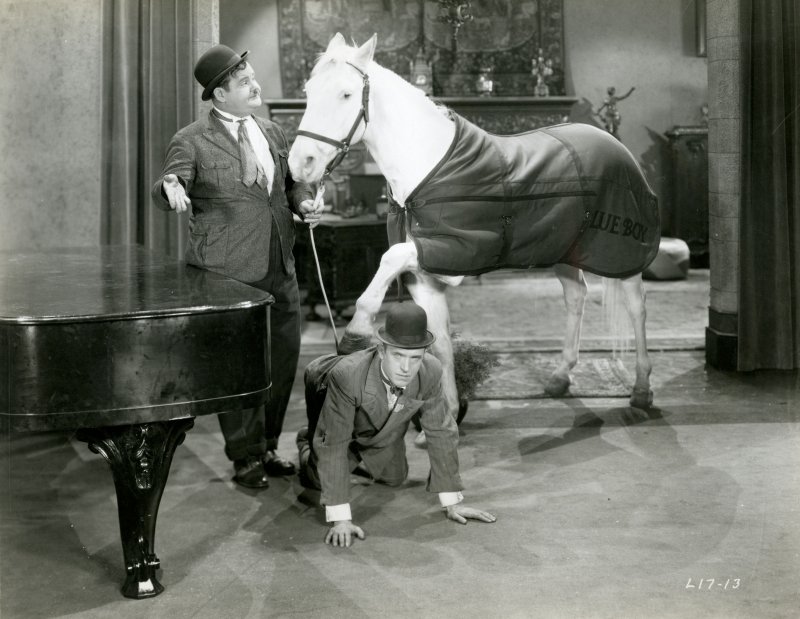
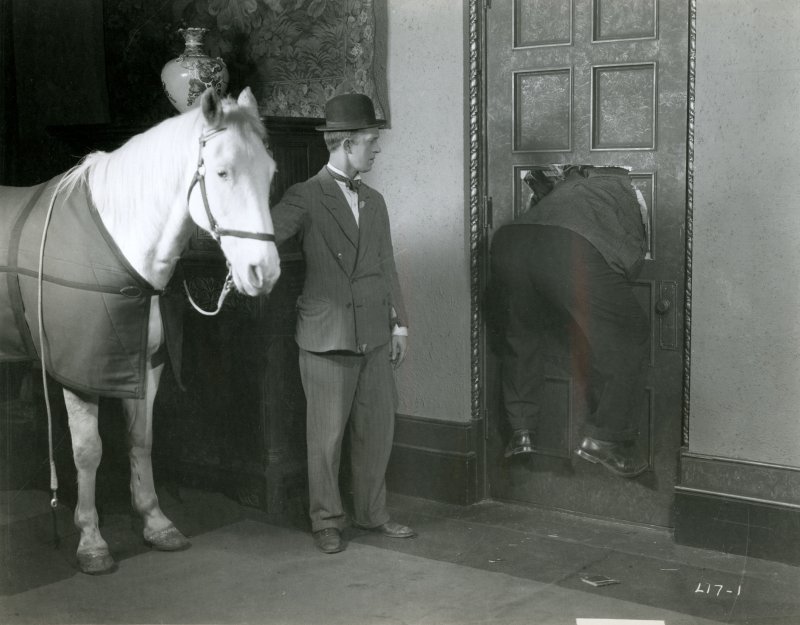
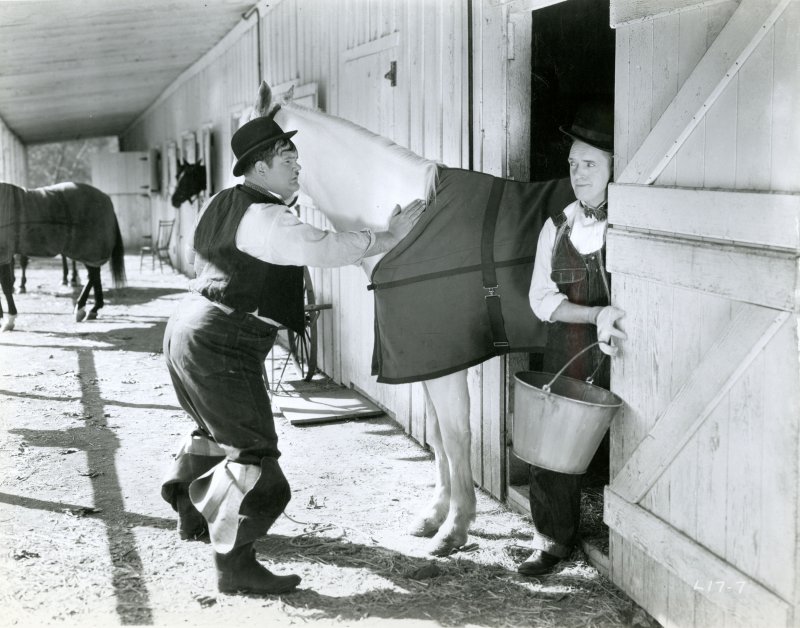 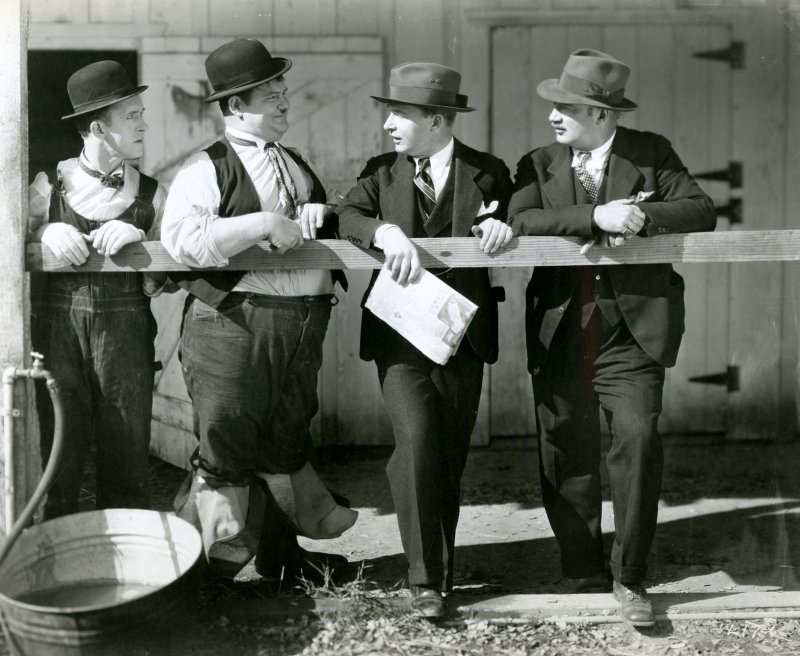
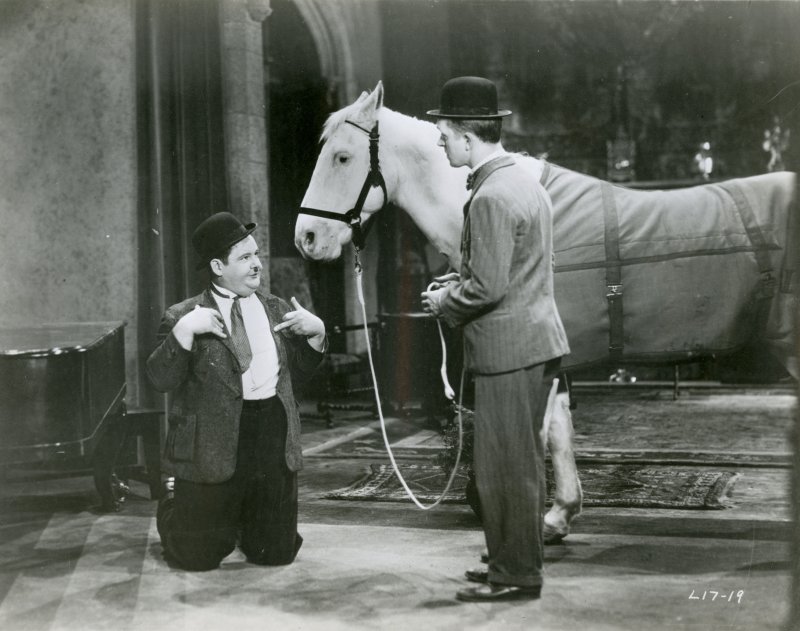
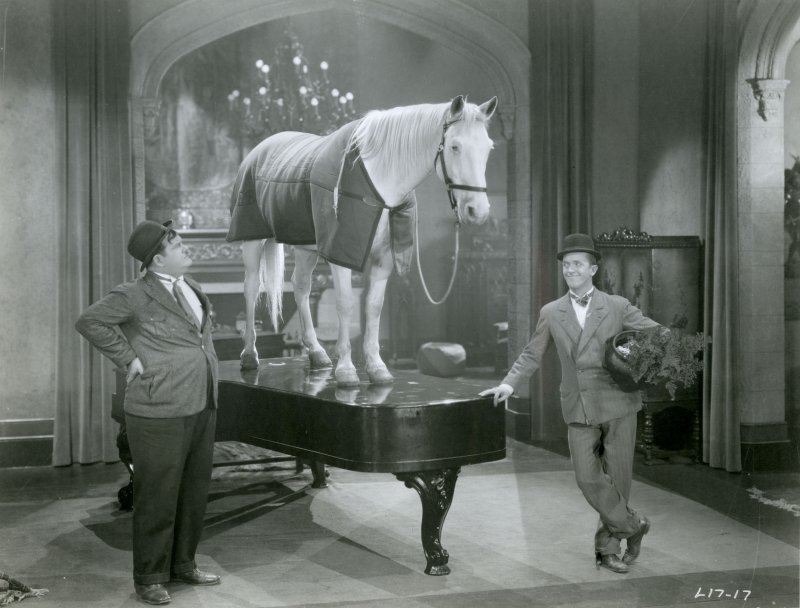
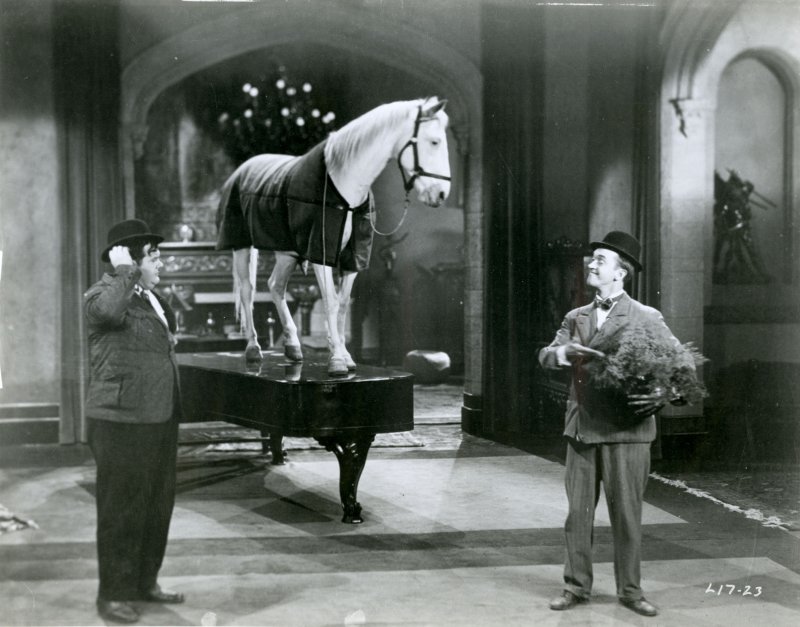
|
| ON-SET PHOTOGRAPH (courtesy Randy Skretvedt) (click any image to enlarge) 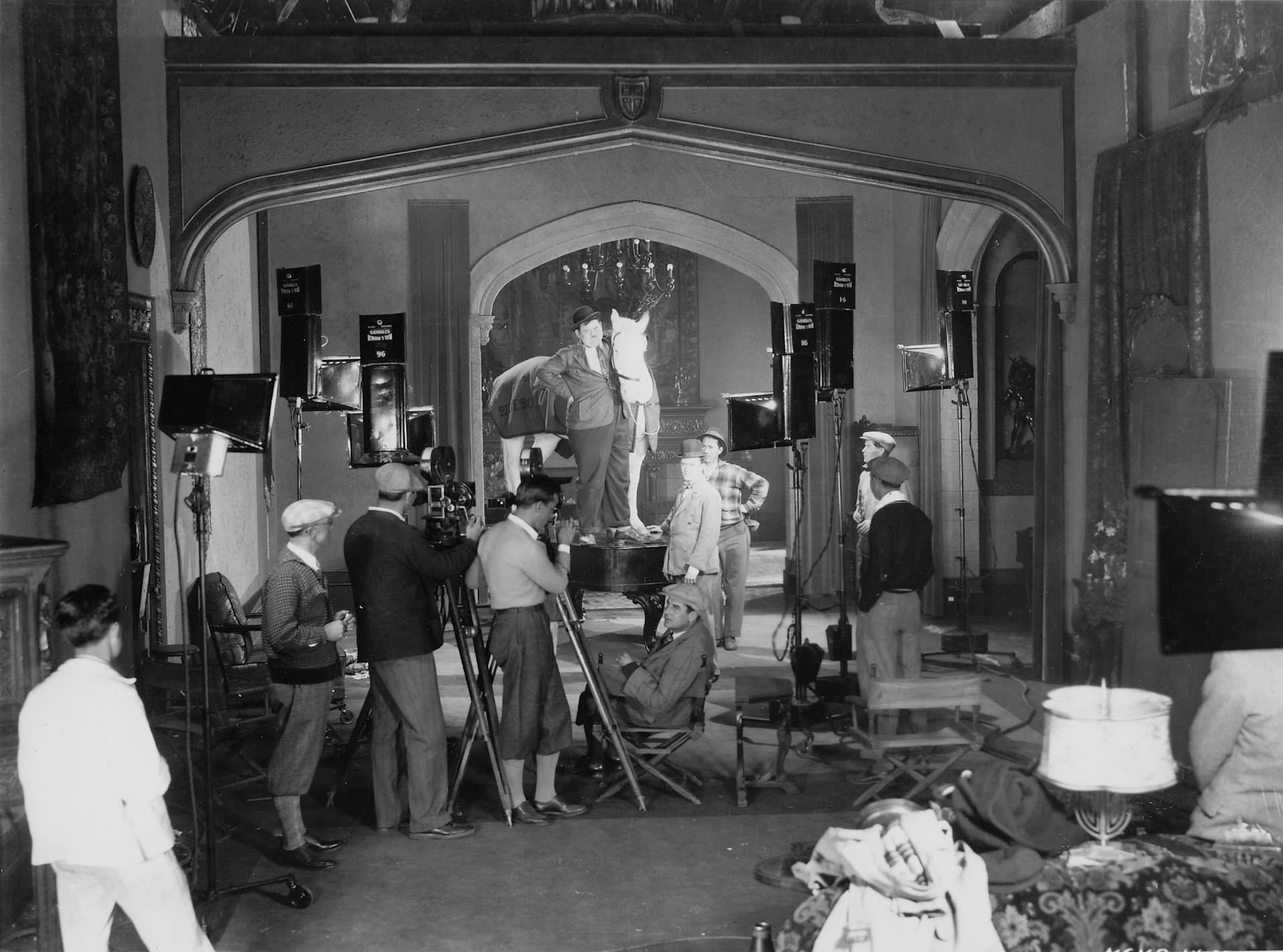
|
| Acknowledgements: Laurel And Hardy: The Magic Behind The Movies by Randy Skretvedt (book) Richard W. Bann (identification of Jack Roach) This page was last updated on: 09 October 2025 |